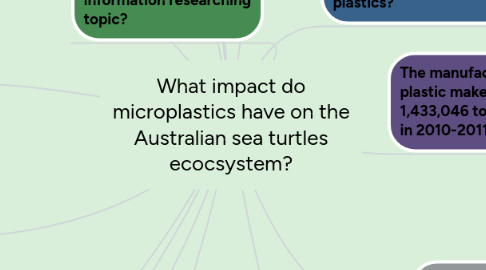What impact do microplastics have on the Australian sea turtles ecocsystem?
Door Kristie Morris


1. What plans are in place to minimise sea turtles exposure to microplastics?
2. Plastic bags are known to be consumed by turtles as they are mistaken for Jellyfish, the turtles common prey (Boyle & Limpus, 2008)
3. research peer reviewed articles
4. Government websites
5. Curtin library
6. Google scholar
7. What can be done to minimise the impact of micro plastic on sea turtles?
7.1. Human intervention or small acts that all can consider
7.2. Community clean ups-short term (Australian Department of Environment & Energy (DEE), 2017)
7.3. Can more be done? If so, what are the future options?
8. Best place to look for information researching topic?
9. What are micro plastics?
9.1. How do plastics become micro plastics?
9.2. Primary micro plastics are microplastics created and manufactured to be used. Items such as cosmetics, toothpaste and detergents include microplastics (West, 2018)
9.3. Secondary Microplastics are larger plastic products that break down into smaller debris. Items such as plastic bottles and plastic bags (West, 2018)
10. The frequency microplastics are encountered by sea turtles
10.1. The sea turtles likelihood of entanglement increases if exposure increases (DEE, 2017)
11. How do sea turtles improve the marine ecosystem?
11.1. Help by grazing on sea beds, allowing fish to access food sources (WWF, 2018)
11.2. Look at other ways sea turtles improve the marine ecosystem
12. How and why do sea turtles ingest plastic?
13. Look at survival rate of sea turtles after ingestion of plastics?
13.1. How much microplastics needs to be consumed to have an impact on the sea turtle
14. Look at impact in Australia
14.1. While a global issue remain focused on Australian waters and the affect on the sea turtle in Australia
15. The manufacturing of single use plastic makes up 37% of 1,433,046 tonnes of plastic used in 2010-2011 (Reisser et al, 2013)
15.1. What can be done to minimise single use plastic
15.2. What can be done to help minimise plastic entering our oceans?
16. Linking to Australian curriculum science
16.1. What year levels?
16.2. Use and influence of science. ACSHE022-People use science in their daily lives, including when caring for the environment and living things. ((Australian Curriculum and Assessment Reporting Authority [ACARA], n.d.). Grade 1.
16.3. Biological science- ACSSU211- Living things live in different places where their needs are met (ACARA, n.d). Grade 1
16.3.1. Exploring what happens when habitats change and some living things can no longer have their needs met (ACARA, n.d)
